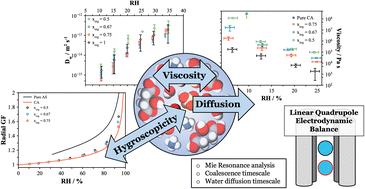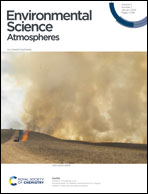Exploring the hygroscopicity, water diffusivity, and viscosity of organic–inorganic aerosols – a case study on internally-mixed citric acid and ammonium sulfate particles†
Abstract
Internally-mixed aerosol particles containing organic molecules and inorganic salts are prevalent in the atmosphere, arising from direct emission (e.g., from the ocean) or indirect production by condensation of organic vapors onto existing inorganic particle seeds. Aerosol particles co-exist with water vapor and, under humid conditions, will exist as dilute aqueous solution particles that can be well described by thermodynamic models. Under low humidity conditions, the increase in solute concentrations leads to molecular interactions and significant non-ideality effects that drive changes in important physical properties, such as viscosity and phase state, that are not predicted using simple models. Here, we explore a model system containing ammonium sulfate (AS) and citric acid (CA). We measure the hygroscopicity, viscosity, and rate of water diffusion in particles across a range of RH conditions and organic fractions to better understand the influence of organic–inorganic mixtures on particle properties. We report the RH dependence of these properties and explore the applicability of commonly used methods that connect them together, such as the Stokes–Einstein relationship and thermodynamic modelling methods. We show that at low RH, the addition of AS to CA leads to a reduction in the amount of water as indicated by the radial growth factor at a fixed RH, while observing an increase in the viscosity over several orders of magnitude. Contrary to the viscosity, only minor changes in water diffusion were measured, and analysis with the fractional Stokes–Einstein relationship indicates that changes in the molecular matrix due to the presence of AS could explain the observed phenomena. This work reveals that small additions of electrolytes can drive large changes in particle properties, with implications for chemical reactivity, lifetime, and particle phase that will influence the environmental impacts and chemistry of aerosol particles.

- This article is part of the themed collection: Particle Levitation to Address Challenges in Atmospheric Science


 Please wait while we load your content...
Please wait while we load your content...